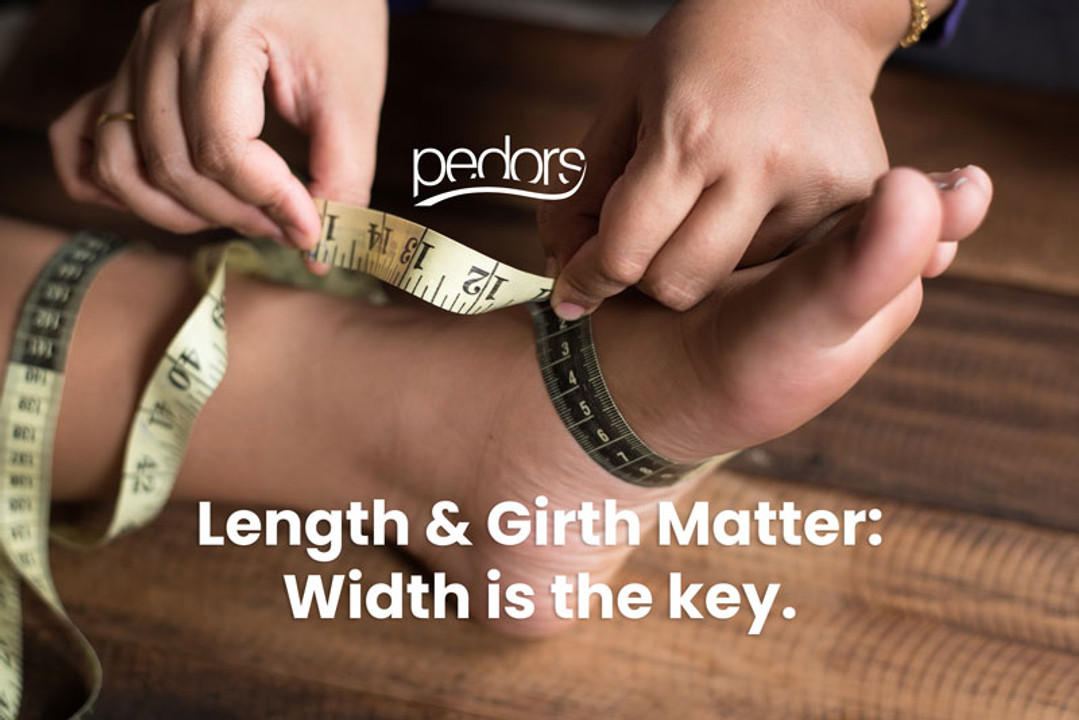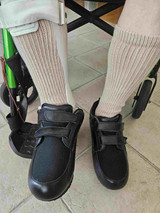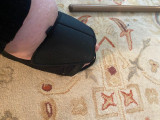For Shoes Length & Girth Matter. Width is the Key.
Helping patients find the footwear they need for swollen feet edema and lymphedema
Modern pharmacological advances in treating disease often result in the lymphatic system being compromised which in turn can lead to severe swelling in feet. Many patients and healthcare providers are left struggling to find accommodative footwear to manage these specific needs. The Pedors Classic MAX was designed to allow the foot to be placed on the footbed and for the shoe to affix to the foot with two long adjustable touch closure straps.
When fitting a shoe to a patient with a swollen foot, arguably the most important measurement to take is for girth. The bones in the adult edematous foot haven’t grown at all in length - they are the same length as they were before the edema came along - the difference is that the foot has become larger by volume.
Provided the shoes being fitted have plenty of depth in the toe-box to accommodate any swelling in the toes, the patient’s normal shoe size in length is usually the size to start from.
To get volume into a shoe, the width is increased incrementally and Pedors characterizes those widths as Medium (B/C), Wide (D/E), Extra-Wide (2E/3E), Extra-Extra-Wide (4E/5E) and Extra-Extra-Extra-Wide as (6E/7E) and even 5X-Wide (10E).
Dependent on the severity of the edema the wider the width required to ensure there is plenty of volume. The Classic MAX in the 6E/7E width works for about 90% of patients with lymphedema – the most severe form of swelling. With 5 widths and 25 sizes the Pedors Classic line offers 125 unique sizes in length, width and girth.

Key Tips For Sizing The Edematous Foot
Step 1) Determine the Best Time of Day To Measure
It makes the most sense to measure your feet when they are normally at their most swollen as this is what the shoe will need to accommodate. For most people that is late afternoon to early evening. If one foot is different in size to the other you may need to evaluate for different sized shoes for each foot, so it makes sense to measure both feet.
Step 2) Take a tracing of the foot
Trace both feet and measure the longest length to the nearest 1/8th of an inch. To be sure these measurements are as accurate as possible, it’s recommended that a rectangle be drawn around the tracing so that the tracing is flush inside the rectangle. Then measure the length of the rectangle.
Step 3) Take a girth measurement
Using a tailor’s tape (or a piece of string) and measure the length around the instep - the circumference - and again measure to the nearest 1/8th of an inch.
Step 4) Make a determination for the best size shoe to order
Select the shoe size that matches the length of your tracing.Then review the girth measurement table and determine the appropriate width required to accommodate your girth. If there is more than two width difference between your feet or more than a half size difference in length, consider buying two pairs of shoes to make the ideal single pair. Although it will cost more money to get a mis-mate pair, it will be considerably less than having a custom pair of shoes made and will help reduce the risk of fall due to ill fitting footwear.
Notes: In some instances of extreme edema, it could be determined that by going up a half size the girth requirement may meet the volume need. It is not recommended that you go up more than one full size as this will increase the risk of tripping.
Please click the SIZING link at the top of this page.
Step 5 if needed: Shedule FREE Consultation
We’ve helped thousands of people like you find the footwear solution they need for their foot problem. Book a consultation by clicking the link on the homepage.
Explore Popular Articles
I would encourage you to buy Pedors, you will not be sorry that you did.
Why I Wear Pedors - by Bill B Do you mind sharing in general terms your primary foot issue or issues...
I love my Pedors Sandals
I love my Pedors Sandals, by Sandy W Because of lymphedema in both legs and feet, I have not been...
Tell Your Pedors Story #5 - Carlo and Pedors
Do you mind sharing in general terms your primary foot issue or issues? Since early 2023, I have suf...
Tell Your Pedors Story #4 - Debbie S
Hi, my husband has swollen feet and legs. He was not able to put his feet into shoes. I spent hours...
Tell Your Pedors Story #3 - Donna J
Tell Your Pedors Story #3 - Donna J - Shoes For Lymphedema and Lipodema After reading Donna's amazin...
Tell Your Pedors Story #2 - Mildred and Penny D
Wedding Shoes For Swollen Feet Penny conversed with me over email after I reached out to her mothe...




